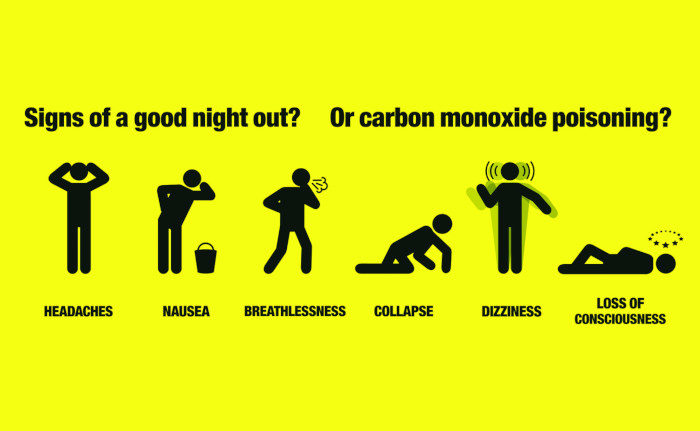Carbon monoxide, or “CO,” is an odorless, colorless gas that can kill you. CO is found in fumes produced any time you burn fuel in cars or trucks, small engines, stoves, lanterns, grills, fireplaces, gas ranges, or furnaces. CO can build up indoors and poison people and animals who breathe it. The most common symptoms of CO poisoning are headache, dizziness, weakness, upset stomach, vomiting, chest pain, and confusion. CO symptoms are often described as “flu-like.” If you breathe in a lot of CO it can make you pass out or kill you. People who are sleeping or drunk can die from CO poisoning before they have symptoms.
Everyone is at risk for CO poisoning. Infants, the elderly, people with chronic heart disease, anemia, or breathing problems are more likely to get sick from CO. Each year, more than 400 Americans die from unintentional CO poisoning not linked to fires, more than 20,000 visit the emergency room, and more than 4,000 are hospitalized.
Carbon monoxide poisoning occurs when carbon monoxide builds up in your bloodstream. When too much carbon monoxide is in the air, your body replaces the oxygen in your red blood cells with carbon monoxide. This can lead to serious tissue damage, or even death.
Carbon monoxide is a colorless, odorless, tasteless gas produced by burning gasoline, wood, propane, charcoal or other fuel. Improperly ventilated appliances and engines, particularly in a tightly sealed or enclosed space, may allow carbon monoxide to accumulate to dangerous levels. If you think you or someone you're with may have carbon monoxide poisoning, get into fresh air and seek emergency medical care.
The Invisible Killer: Carbon Monoxide
It's not an intriguing or novel hazard, just the persistent, invisible killer: carbon monoxide. Seriously, you still don't have a carbon monoxide alarm in every sleeping area of your home? Get one! And keep fuel-burning appliances in good repair; don't use grills or gasoline-powered tools indoors, and don't run your car in an attached garage or place a generator close to your home.
Make no mistake: carbon monoxide kills. Carbon monoxide gas is produced when ordinary fuels burn, for example gasoline, kerosene, wood, propane, and natural gas. Carbon monoxide gives no hint of its presence; it is colorless and odorless. When you breathe it in, carbon monoxide prevents your blood cells from carrying enough oxygen. The brain and heart suffer quickly, but all body organs are harmed by lack of oxygen. High levels of carbon monoxide can kill quickly, but even low levels can have long-lasting effects. Permanent brain damage can result.

Eliminate this deadly poison from YOUR home!
- Have every appliance that burns gas, wood, or kerosene inspected. This includes furnaces, ovens and stoves, water heaters, clothes dryers, fireplaces, wood-burning stoves, and space heaters. Be sure they are operating correctly and that flues, chimneys, and vents are clean and in good repair.
- Don't use gasoline-powered tools and engines indoors.
- Make sure exhaust fumes from generators cannot enter your home.
- Never leave a car running in an attached garage - even if the garage door is open.
- Clear snow from around vents and pipes such as clothes dryer vents and car exhaust pipes.
- Do not try to heat your home by turning on a gas oven.
- Never burn charcoal and never use portable fuel-burning camping equipment inside a home, garage, vehicle, or tent.
Detect carbon monoxide leaks!
- Install a carbon monoxide alarm in the hallway near every sleeping area in the home. Follow installation instructions, but usually carbon monoxide alarms should be placed on the wall about five feet above the ground. A variety of alarms are available at hardware stores and home centers. Fire departments often offer free alarms for families who can’t afford to purchase them.
- Check the battery at least twice a year, when you check your smoke alarm battery.
- If the alarm sounds, leave the home immediately and call your local fire department.

Suspect carbon monoxide poisoning when:
- Headaches, nausea, and/or flu-like symptoms clear up when you go outdoors.
- Several people develop symptoms of headache, nausea, and fatigue or drowsiness at the same time.(Children and pets are often affected first.)
Call for help if you suspect carbon monoxide poisoning!
- If someone is unconscious, not breathing, or having seizures, call 911 immediately.
- Otherwise, call Poison Control at 1-800-222-1222 for guidance. Poison Control will give you personalized advice right away.



